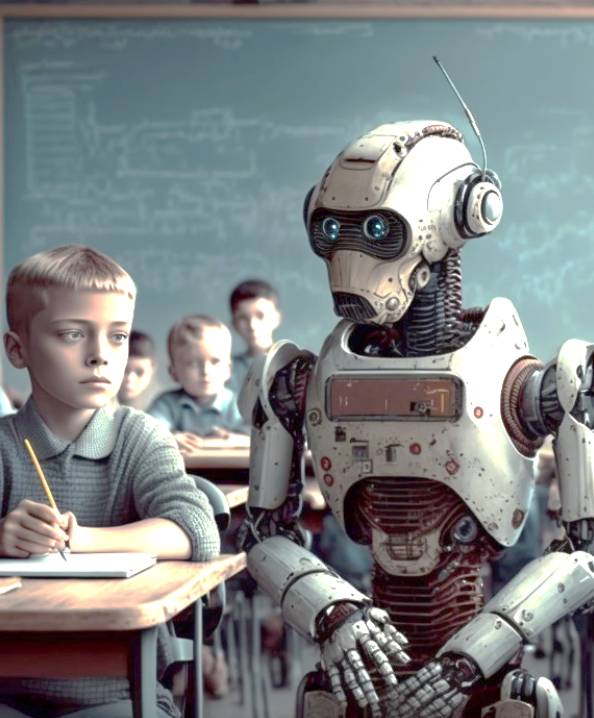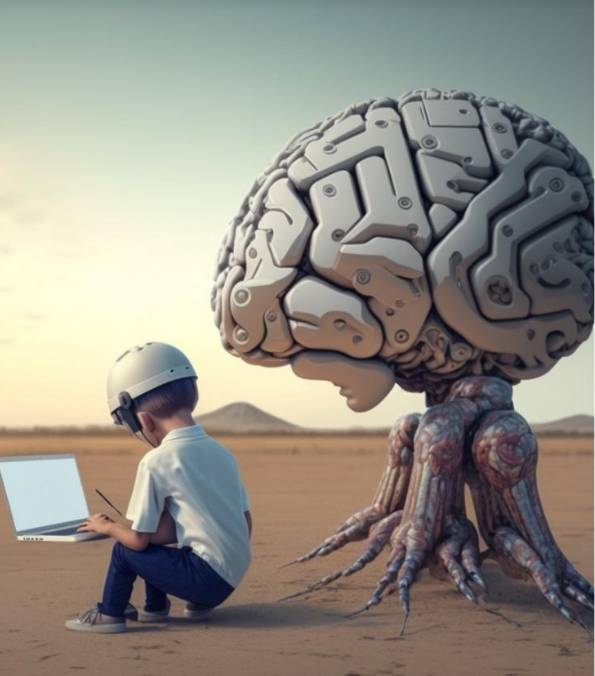The Impact of Artificial Intelligence (AI) on Third Level Education

The release of OpenAI’s ChatGPT chatbot has given us a glimpse into the future of teaching and learning alongside artificial intelligence. GPT (short for “Generative Pre-trained Transformer”) is a type of natural language processing (NLP) model developed by OpenAI. It can generate human-like text by predicting the next word in a sequence based on the context of the previous words. This technology has the potential to revolutionise the way we think about education, particularly at the third level. Many are fearful of such disruptions, but if we embrace it, it has the potential to empower students and teachers.
Impact of AI on Education
The impact of AI on the education sector is immense and rapidly growing. AI is revolutionising the way students learn, interact with teachers, and develop skills. AI-enabled solutions and tools are empowering teachers and students by providing a wide range of learning and teaching options. AI-powered virtual teaching assistants are helping teachers to grade homework, provide real-time feedback, and manage administrative tasks. AI can also help students find answers to their most commonly asked questions in seconds through support automation and conversational intelligence.
How Can AI Be Applied to the Education Sector?
One of the main benefits of GPT for education is its ability to provide personalised learning experiences. Traditional education often involves a one-size-fits-all approach, with students expected to learn at the same pace and in the same way. GPT, on the other hand, can adapt to an individual student’s needs and learning style. For example, a student who is struggling with a particular concept could be provided with additional resources and explanations explicitly tailored to their needs.
GPT can also be used to create interactive learning materials, such as chatbots or virtual tutors. These tools can provide students with immediate feedback and support, making it easier for them to stay on track and stay motivated. Moreover, students can access these resources at any time, from any location, which can be especially beneficial for those who are unable to attend in-person classes due to geographical or other constraints.
Another potential application of GPT in education is in the creation of customised course content. Instead of being limited to pre-existing materials, teachers could use GPT to generate custom lesson plans and assignments based on the needs and goals of their students. This could allow for a more dynamic and engaging learning experience, as well as provide an opportunity for students to explore topics of particular interest to them.
In addition to these direct applications of AI, the technology can also be used to improve the quality of education in other ways. For instance, AI can be used to analyse student performance data to identify areas for improvement, allowing for better targeted interventions and instruction. AI can also be used to identify and analyse trends in student performance, allowing educators to better understand the factors that may contribute to student success.
Examples of How an Educator Could Use AI Tools in the Classroom
- Using AI-powered chatbots to answer student questions and provide additional resources.
- Utilising AI-driven instructional tools, such as personalised learning activities, to differentiate instruction for individual student needs.
- Automating grading and feedback with AI-powered tools that scan, analyse, and grade student assignments.
- Utilising AI-powered voice assistants to provide auditory feedback, or to ask and answer questions.
- Incorporating AI-driven tutoring systems to provide individualised instruction and guidance.
- Leveraging AI-driven simulations and virtual reality to create immersive learning experiences.
- Using AI-powered analytics to identify trends and patterns in student behaviour and performance.
- Leveraging AI-driven natural language processing to understand student sentiment and preferences.
- Incorporating AI-driven sentiment analysis tools to identify and respond to student moods.
How Will AI Affect Assessment?
The power of AI systems is placing a huge question mark over our education and assessment practices. Assessment in schools and universities is mostly based on students providing some product of their learning to be marked, often an essay or written assignment.
With AI models, these products can be produced to a higher standard, in less time and with very little effort from a student. In other words, the product a student provides may no longer provide genuine evidence of their achievement of the course outcomes. It will become increasingly difficult to attribute these responses to a particular source – making it difficult to detect plagiarism.

Shortly after ChatGPT’s release, OpenAI announced it was developing a “digital watermark” to embed into the chatbot’s responses. This kind of watermark is embedded as a digital signal that can identify the content as being AI-generated, and which (in theory) should be difficult to remove.In reality, the focus of the Educator must be on the design of the assignment rather than relying on tools to check for plagiarism.
Educators must create imaginative, real-world case studies, that are both practical and effective, rather than an immediate reaction of bringing learners back into the classroom to complete closed book written examinations.
What Does This Mean for Educators?
Moving forward, we’ll need to think of ways AI can be used to support teaching and learning, rather than disrupt it. Here are three ways to do this:
1. Integrate AI into classrooms and lecture halls
History has shown time and again that educational institutions can adapt to new technologies. In the 1970s, the rise of portable calculators had maths educators concerned about the future of their subject – but it’s safe to say maths survived.
Just as Wikipedia and Google didn’t spell the end of assessments, neither will AI. In fact, new technologies lead to novel and innovative ways of doing work. The same will apply to learning and teaching with AI. Rather than being a tool to prohibit, AI models should be meaningfully integrated into teaching and learning.
2. Judge students on critical thought
One thing an AI model can’t emulate is the process of learning, and the mental aerobics this involves. The design of assessments could shift from assessing just the final product, to assessing the entire journey that led a student to it. The focus is then placed squarely on a student’s critical thinking, creativity and problem-solving skills. Students could freely use AI to complete the task and still be marked on their own merit.
3. Assess things that matter
Instead of switching to in-class examination to prohibit the use of AI (which some may be tempted to do), educators can design assessments that focus on what students need to know to be successful in the future. AI, it seems, will be one of these things. AI models will increasingly have uses across sectors as the technology is scaled up. If students will use AI in their future workplaces, why not test them on it now?
Will We Be “Born Already Educated” in the Future?
With such technologies advancing at such a pace, is it conceivable that in future, people will be born ‘linked’ to their own online hard drive, already loaded with the knowledge and experiences of the past. Why waste so many years accumulating such knowledge, when you could just download it into our personalised memory?

It’s unlikely that people will be “born already educated” due to the introduction of AI. Whilst AI can certainly play a role in facilitating and improving education, it is not a replacement for the human experience of learning and growing. Learning may become more personalised, allowing people to learn at their own pace and in their own way. This approach has been shown to be effective in helping students to achieve greater understanding and retention of the material. However, it is important to remember that AI is just a tool, and the most important part of education still relies on the interaction between a teacher and student.
It is also important to consider that a human touch is still important in education, as it is not just about acquiring knowledge, but also developing social and emotional skills, critical thinking, an opportunity for a meeting of minds, developing creativity and the pure joy and satisfaction of personal development. Education should not just be about what you know but also how you think, how you behave, how you relate to others, and how you understand the world around you. AI can assist in providing an efficient and personalised learning experience but it cannot possibly replace the human experience of education.



















